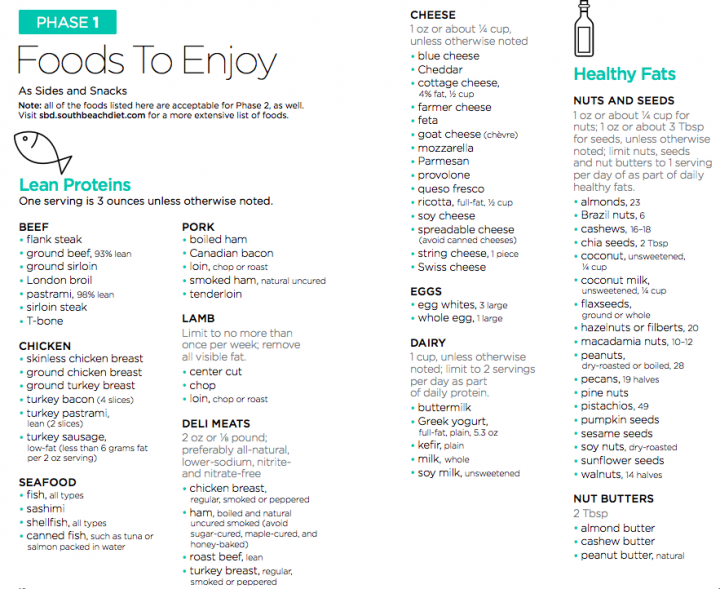South Beach Phase 1 food list forms the cornerstone of this dietary approach, emphasizing a low-carbohydrate, high-protein regimen. This guide delves into the specifics of permitted and prohibited foods, providing a detailed understanding of the nutritional principles behind this initial phase. We’ll explore sample meal plans, recipes, and strategies for overcoming common challenges, ultimately equipping you with the knowledge to successfully navigate South Beach Phase 1.
Understanding the restrictions of Phase 1 is crucial for success. This phase focuses on eliminating foods high in refined carbohydrates and sugars, which often lead to blood sugar spikes and hinder weight loss. By concentrating on lean proteins, healthy fats, and non-starchy vegetables, the diet aims to stabilize blood sugar levels and promote sustained energy throughout the day. This detailed exploration will clarify what constitutes an acceptable meal and offer practical advice for long-term adherence.
Addressing Common Challenges
South Beach Phase 1, while effective for weight loss, presents certain challenges. Many individuals find the initial restrictions difficult to navigate, leading to potential setbacks. Understanding these hurdles and implementing effective coping strategies is crucial for successful adherence to the diet.
The restrictive nature of Phase 1, eliminating many common carbohydrate sources and processed foods, often leads to difficulties. These challenges manifest in various ways, requiring proactive solutions.
Managing Cravings and Hunger
Hunger and cravings are common experiences during the initial phase of the South Beach Diet. The sudden reduction in refined carbohydrates and sugars can trigger intense cravings for sweets and other high-carbohydrate foods. Effective management strategies involve focusing on nutrient-dense foods to promote satiety. Consuming high-protein meals and snacks, such as grilled chicken salad or a handful of almonds, helps curb hunger pangs. Staying hydrated by drinking plenty of water throughout the day also helps manage hunger signals. Furthermore, incorporating healthy fats, like those found in avocados or olive oil, contributes to a feeling of fullness and satisfaction. Planning meals and snacks in advance can prevent impulsive decisions when hunger strikes.
Maintaining Dietary Variety
While Phase 1 limits certain food groups, maintaining dietary variety is achievable. Focusing on a wide range of permitted foods, including lean proteins (fish, poultry, lean meats), non-starchy vegetables (broccoli, spinach, peppers), and healthy fats (olive oil, nuts, avocados), is essential. Experimenting with different cooking methods, herbs, and spices can add flavor and excitement to meals, preventing monotony. For example, a simple grilled chicken breast can be transformed with different marinades or served with various vegetable combinations. Exploring different types of fish, such as salmon, tuna, or cod, and incorporating diverse vegetables ensures a varied and interesting diet.
Meal Preparation and Planning
Effective meal preparation and planning are key to adhering to the South Beach Phase 1 diet. Preparing meals in advance eliminates the temptation of unhealthy convenience foods and ensures adherence to the dietary guidelines. Batch cooking, such as preparing a large batch of roasted vegetables or grilled chicken, can save time and effort throughout the week. Creating a weekly meal plan, outlining breakfast, lunch, and dinner options, helps stay organized and prevents impulsive food choices. This plan should incorporate a variety of permitted foods to ensure adequate nutrient intake and prevent dietary boredom. Packing lunches and snacks for work or other activities further facilitates adherence to the diet. Consider using a food journal to track meals and identify potential areas for improvement in your meal planning.
Wrap-Up
Successfully navigating South Beach Phase 1 requires careful planning and a commitment to understanding the dietary principles. This guide has provided a comprehensive overview of permitted and prohibited foods, along with practical meal planning tips and strategies for managing common challenges. By focusing on nutrient-dense choices and mindful eating habits, individuals can effectively achieve their weight management goals and experience the positive health benefits associated with this dietary approach. Remember, consistency and informed choices are key to long-term success.



